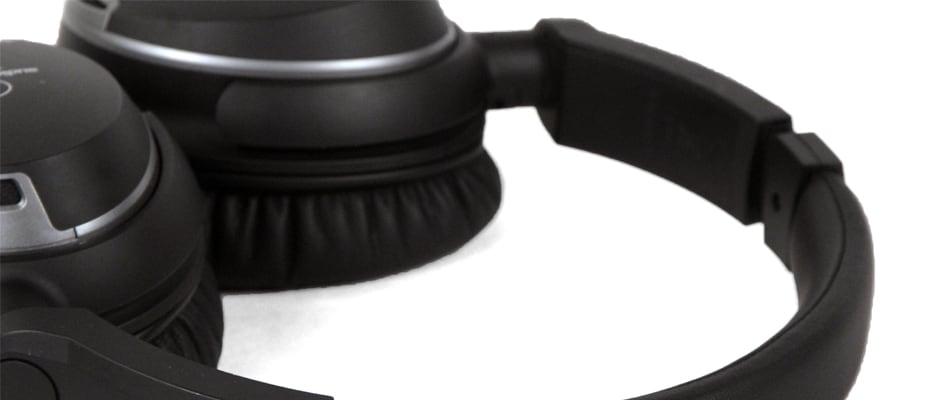Pros
-
Detailed sound
-
Great noise canceling for the money
Cons
-
Sound muted with ANC
Introduction

Meet the ATH-NC9s: active noise canceling, over-ear headphones from Audio-Technica. While they don't offer stellar audio performance, they do pass with middling scores and a good level of active noise canceling. Considering that active noise cancellation is technically destructive noise, it's actually very impressive that Audio-Technica was able to manage the performance given by the ATH-ANC9s. They may not be a fit for audiophiles, but they would work famously on an airplane or subway. At an MSRP of $299, you have to be willing to pay if this type of noise canceling is what you want.
Product Overview
{{section_header}}{{section.name}}{{/section_header}}
Get to know the Audio Technica ATH-NC9
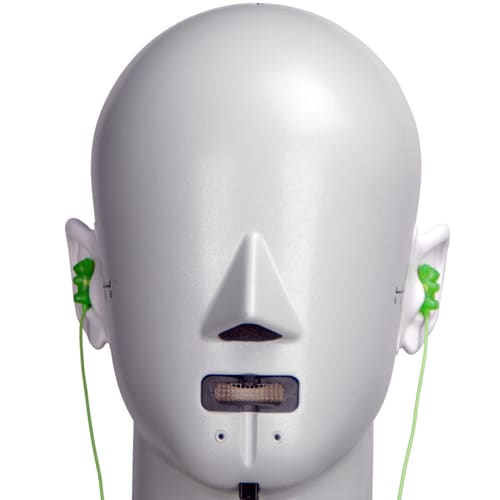
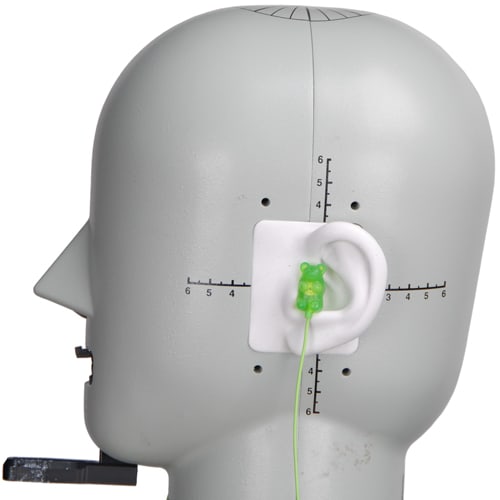
Speakers
{{section_header}}{{section.name}}{{/section_header}}
The speaker element of these headphones is guarded by a very thin layer of mesh, stretched out a good distance away from the driver. This is good news, because it means that you don't have to worry as much when you wipe away bio matter.
Back
{{section_header}}{{section.name}}{{/section_header}}
Here's the back of the Audio Technica cans, along with the active noise cancellation control switch.
Band
{{section_header}}{{section.name}}{{/section_header}}
If you have a large noggin, no worries: the band of these cans can expand large enough to accommodate most craniums. It is also guarded by a soft leather and foam padding.
Cable
{{section_header}}{{section.name}}{{/section_header}}
Included in the packaging for the {{product.name}}s are two removable cables: one with a remote and microphone for smartphone use, and one without. Both are 3.93 feet long.
The standard cables of the {{product.name}} are your ordinary 1/8th inch affairs, but they also come with a 1/4th inch adapter and an airplane adapter.
Possibly the best durability feature any set of headphones can have is a removable cable, and the {{product.name}}s have exactly that. If any of your cables break at any point, just replace 'em.
Additional Features
{{section_header}}{{section.name}}{{/section_header}}
While we discussed the additional features separately above, the total list of additional features include two cables, a 1/4th inch adapter, and an airplane adapter.
In the Box
{{section_header}}{{section.name}}{{/section_header}}
Upon ripping open the box of the {{product.name}}, you'll find a carrying case, your headphones, two cables, a 1/4th inch adapter, an airplane adapter, and assorted documentation.
Durability
{{section_header}}{{section.name}}{{/section_header}}
The {{product.name}}s will be able to survive an inordinate amount of abuse due of the fact that you can simply replace cables if you accidentally break one. These cans won't leave you high and dry.
Aesthetics
{{section_header}}{{section.name}}{{/section_header}}
Despite their durability and their general usability, the {{product.name}}s are not exactly all that easy on the eyes. Not only do they stick out far from the sides of your head, and it's clear that aesthetics were not a priority of Audio-Technica's.
Frequency Response
{{section_header}}{{section.name}}{{/section_header}}
Overall, the frequency response of these cans is a little erratic, but for the most part they stay within our ideal limits. By throwing on the noise canceling unit, the response becomes even more erratic than when it is turned off, and some of the bass frequencies are toned down a bit. Here's what the frequency response looks like with the noise cancelling turned on:

With the noise cancelling turned off, the bass frequencies are emphasized a little bit more, and some of the higher harmonic frequencies drop off a bit, but you probably won't notice that unless you know exactly what you're looking for.
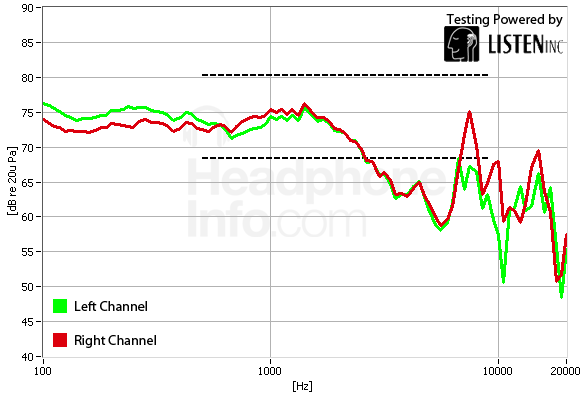
Click here for more information on our frequency response test.
Distortion
{{section_header}}{{section.name}}{{/section_header}}
Due to the fact that active noise cancellation is technically destructive noise, it's no surprise that there's a little bit of distortion added when you enable it on your cans, pictured below:

When you aren't listening to your ATH-NC9s with active noise cancellation, there's very little total harmonic distortion to speak of, though it's not perfect.
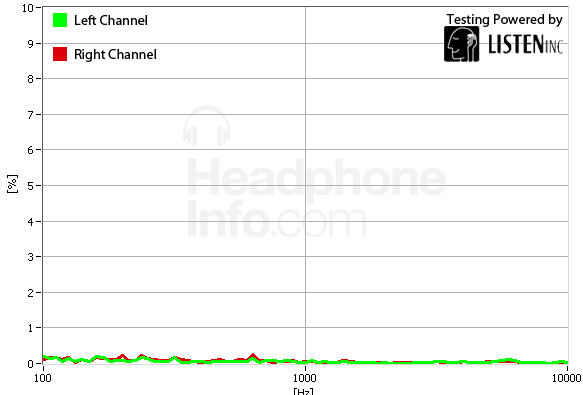
Click here for more information on our frequency response test.
Tracking
{{section_header}}{{section.name}}{{/section_header}}
Headphones that use active noise cancellation circuits typically perform better in many areas when they are actively canceling noise, and the same holds true with the {{product.name}}s. Still, there are a few channel shifts that you will definitely hear, and can get distracting, especially in the higher end.
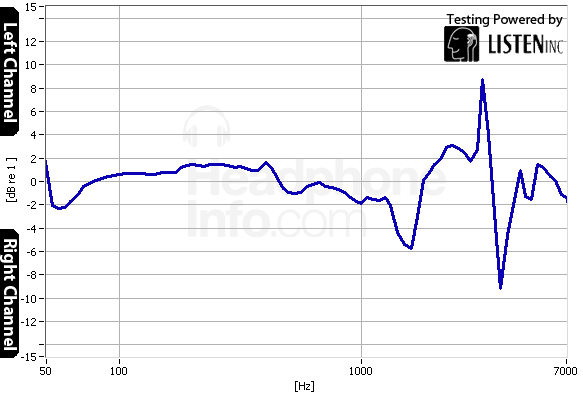
When the unit is off, however, the channel preferences are very erratic, and wildly so. A very bad response here.
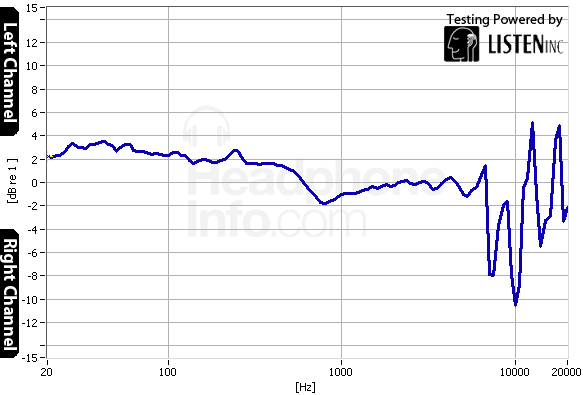
Click here for more information on our frequency response test.
Isolation
{{section_header}}{{section.name}}{{/section_header}}
When you go out into the world with your music, outside noise is a huge problem that can ruin your experience. Headphones with noise-cancellation circuits, like the {{product.name}}, actively neutralize outside noise. Overall, these cans do a great job of canceling out noise in the low end, and attenuating noise in the high end, so outside noise won't be quite as annoying. Good job, Audio-Technica!
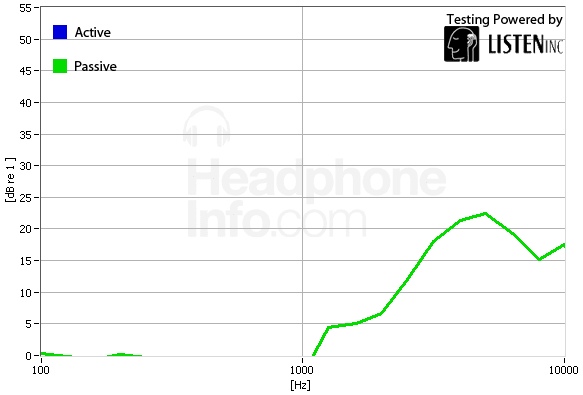
Click here for more information on our isolation test.
Leakage
{{section_header}}{{section.name}}{{/section_header}}
Maybe it's due to the seal, maybe it's due to the active noise cancellation, but the {{product.name}}s corral their own sound very well. You won't pester everyone else with your music.
Click here for more information on our leakage test.
Maximum Usable Volume
{{section_header}}{{section.name}}{{/section_header}}
Despite the fact that the {{product.name}}s can bump tunes out at about 110dB without hitting 3% total harmonic distortion, we advise you not to crank your volume to the maximum with these headphones. Why? Because you could seriously jeopardize your hearing.
Click here for more on our maximum usable volume test
Short-Term Use
{{section_header}}{{section.name}}{{/section_header}}
When you first place the {{product.name}}s on your head, you'll notice that they firmly grip your head, and the band is a little on the difficult side to adjust. Once you get past that small hurdle, these headphones form a good seal, and don't let go of your noggin. Some discomfort was reported by those with larger heads, but for the most part, no major issues were found.

Extended Use
{{section_header}}{{section.name}}{{/section_header}}
Over time, the fit doesn't really change in any way, so these headphones nab the same score.
Customizability
{{section_header}}{{section.name}}{{/section_header}}
Aside from swapping out your cable or using an adapter, there really isn't a whole heck of a lot that you can do to customize your headphones beyond those two things.
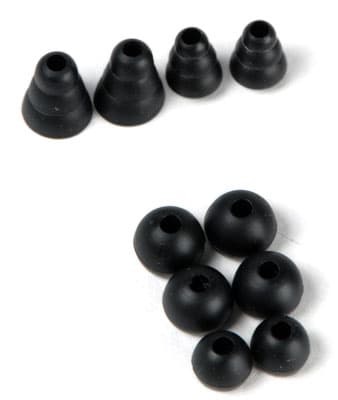
Cable Connectivity
{{section_header}}{{section.name}}{{/section_header}}
Both of the {{product.name}}'s 3.93 foot long cables have a 1/8th inch plug, though only one of them has an in-line remote with a mic. There are also two adapters: a 1/4th inch adapter, and an airplane adapter that will allow you to sidestep the robbery that is the in-flight movie headphone rental.
Portability
{{section_header}}{{section.name}}{{/section_header}}
While over-ear cans are usually not that portable, the {{product.name}}s come with a carrying case that is... well... not that tiny. In fact, the bulky ear cups of the {{product.name}}s make them less than ideal to carry around with you, even if you find a place to stow them.
Maintenance
{{section_header}}{{section.name}}{{/section_header}}
Beyond swapping out broken cables, there really isn't a whole lot you can do to maintain your {{product.name}}s. Still, that detachable cable is a huge plus, and will greatly extend the length of life for your headphones.
Other Features
{{section_header}}{{section.name}}{{/section_header}}
Battery
Having to rely on a battery is a terrible, but necessary evil for headphones that use active noise cancellation. While the battery didn't run down in over 28 hours of use at the lab, eventually it will die on you. As with any device that requires batteries to operate, there will be a certain upkeep cost, which should factor into your purchase.
Remote & Mic
There isn't a whole lot that's interesting or special about the remote, but that's not a bad thing: it performs its function and doesn't get in the way. Still, remember that added solder points mean added potential for breakage.
Active Noise Cancellation
All things considered, the active cancellation works pretty well on the {{product.name}}s. While they aren't the best we've seen at this task, they do block out a bunch of low-end noise. Once you flip the switch on the left ear cup, you'll hear the difference almost immediately.
Design
{{section_header}}{{section.name}}{{/section_header}}
By design, over-ear headphones aren't that different from each other, but the Bose cans have a few more options, and a wildly different design aesthetic.
Frequency Response
{{section_header}}{{section.name}}{{/section_header}}
While both responses are fairly erratic, neither one is clearly better than the other. The {{product.name}}s maintain a more uniform consistency than the Bose cans.
Distortion
{{section_header}}{{section.name}}{{/section_header}}
Both sets of headphones have distortion issues.
Tracking
{{section_header}}{{section.name}}{{/section_header}}
Both sets of cans have their issues with tracking, but the {{product.name}}s are worse for more frequencies.
Isolation
{{section_header}}{{section.name}}{{/section_header}}
Even though the {{product.name}}s do well enough, the Bose QC15s are still king.
Comfort
{{section_header}}{{section.name}}{{/section_header}}
Because there are no major issues with either set of headphones, we'd like to admonish you that comfort generally comes down to personal preference. Sine the only way to know how well something fits your head is to actually go out and try it on, find your local headphone retailer and give it a shot before you buy.
Verdict
{{section_header}}{{section.name}}{{/section_header}}
With no slam-dunk advantages over one another, the only result that sticks out is the Bose QC15's better noise canceling. Still, you can't actually turn the noise canceling off, so you chew through batteries much faster than you would with the {{product.name}}. The decision is up to you, as there isn't a huge price difference either.
Design
{{section_header}}{{section.name}}{{/section_header}}
By design these two sets of headphones are extremely similar, right down to the shape of the ear cups. They even both have removable cables.
Frequency Response
{{section_header}}{{section.name}}{{/section_header}}
Neither of these frequency responses are what we'd call "good", but the response of the {{product.name}} is significantly better owing mainly to the fact that they don't have the severe underemphasis in the 1-3kHz range.
Distortion
{{section_header}}{{section.name}}{{/section_header}}
Both headphones have their share of distortion issues.
Tracking
{{section_header}}{{section.name}}{{/section_header}}
Neither set of headphones has anything closely resembling an "average" tracking response, so you'll definitely notice channel preference shifts with either set of cans.
Isolation
{{section_header}}{{section.name}}{{/section_header}}
The {{product.name}}s isolate better, and cancel more low-end noise than the Able Planet cans, hands-down.
Comfort
{{section_header}}{{section.name}}{{/section_header}}
Because these headphones are both very similar in design, the only way you're going to know which one fits you best is to try them on. Be forewarned though, that the NC1050s aren't as forgiving as the {{product.name}}s are to larger noggins, so be sure to see how each fits before buying.
Verdict
{{section_header}}{{section.name}}{{/section_header}}
Given that both sets of headphones are at a similar price point, we'd side with the {{product.name}}s based on their isolation alone. While both sets of cans have their problems, the severe underemphasis in the mid frequencies will harm your listening experience far more than an erratic frequency response ever could.
Design
{{section_header}}{{section.name}}{{/section_header}}
By design, in-ear headphones are vastly different than over ears, right down to the drivers. Due to design differences, there are performance, durability, and comfort tradeoffs. For example, the Sonys are less durable and comfortable, but they do have a much better audio performance.
Frequency Response
{{section_header}}{{section.name}}{{/section_header}}
The XBA-3s have a fantastic frequency response, while that of the {{product.name}} is erratic, to say the least.
Distortion
{{section_header}}{{section.name}}{{/section_header}}
Oddly enough, the XBA-3s have the worse level of distortion here, as they have a high distortion power sum.
Tracking
{{section_header}}{{section.name}}{{/section_header}}
The XBA-3s are nearly perfect in their tracking response, while the {{product.name}}s struggle quite a bit here.
Isolation
{{section_header}}{{section.name}}{{/section_header}}
While the XBA-3s don't block out as much sound total as the {{product.name}}s, they do block out a considerable amount of noise without active cancellation, though the mid-range and low frequency noise will still get into your ear canals.
Comfort
{{section_header}}{{section.name}}{{/section_header}}
In-ears are typically not all that comfortable, as they put pressure on your ear canal to stay in place. By virtue of this fact alone, it's highly probable that you'll find the {{product.name}}s to be more comfortable.
Verdict
{{section_header}}{{section.name}}{{/section_header}}
If you're looking for a mobile solution, you've got options here. At half the price, the Sony XBA-3s offer you quite a few arguments to forget other headphones, but they do have a high level of distortion, and no remote. The {{product.name}}s on the other hand have average sound performance, high durability, and a remote if you so choose.
Conclusion
{{section_header}}{{section.name}}{{/section_header}}
If you've been looking at active noise cancelling headphones, you've likely been disappointed by their poor audio quality in the past. In our testing, we haven't found a single set of cans that balances noise cancellation and good performance, but the {{product.model}}s do better than most. There are several reasons why, but for those of you just looking for a set of cans that will make the world around them disappear, there are inherent tradeoffs to this type of technology.
All that being said, the {{product.name}}s make do with their lot, and give their users a notably decent performance at their price point. Unfortunately active noise canceling technology is still a ways away from satisfying audiophiles, especially when they're outperformed by headphones that are less than half their cost. It's important to factor in the fact that these headphones are very good at canceling noise, but that means that they have a very specialized use.
Many people want headphones for their commute. If there's a bunch of outside noise you'd like to get rid of, the Audio-Technica ATH-NC9s fill that role quite nicely, and without a huge tradeoff in audio quality. Despite their scores, these are not bad headphones by any stretch: they're great if what you're looking for is noise cancellation, but that's it. We'd recommend looking elsewhere if you're more worried about raw performance.
Meet the tester
A seasoned writer and professional photographer, Chris reviews cameras, headphones, smartphones, laptops, and lenses. Educated in Political Science and Linguistics, Chris can often be found building a robot army, snowboarding, or getting ink.
Checking our work.
Our team is here to help you buy the best stuff and love what you own. Our writers, editors, and experts obsess over the products we cover to make sure you're confident and satisfied. Have a different opinion about something we recommend? Email us and we'll compare notes.
Shoot us an email
